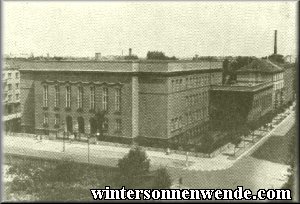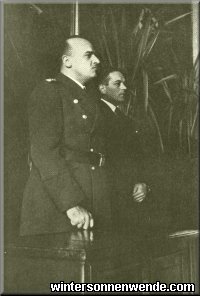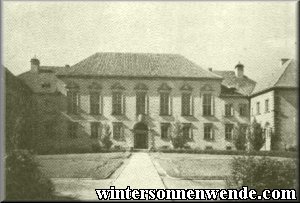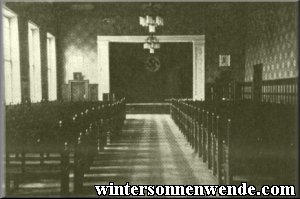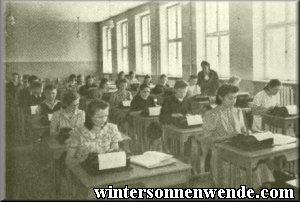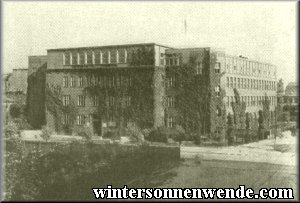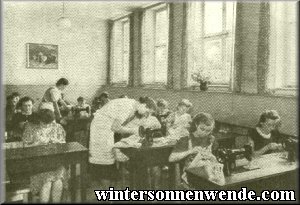 |
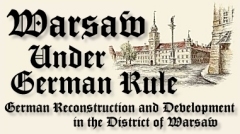 The School System
1. Suppression of the German School System by the Republic of Poland
German precentorial schools* were established in the mid-1800s, but were often aggressively discouraged by the Russian governorate administration. In this context the attitude and actions of the Protestant parish priests of those times must be highly recommended; they successfully interceded with the Russian government on behalf of the establishment of German schools, thus preventing the Polonization or Russianization of the German ethnic minorities. Approximately 40 such precentorial schools had survived in the region of the present-day District of Warsaw up until the beginning of the [first] world war. In the course of the world war, during the period of German occupation, the German school system experienced a temporary improvement. The German schools were united in a Regional School Association which administered them uniformly. After the world war the newly-created Polish state put an abrupt stop to this promising development. Already on March 3, 1919, the Polish government dissolved the German Regional School Association and distributed its assets among the Polish schools. The German schools were placed under state control and thus effectively divested of their German character, so that they were doomed to defeat. In fact, of the approximately 40 schools which had existed in the region of the present District of Warsaw until 1919, not a single one was left by early 1939; those few schools which the Polish still called "German schools" were German only on paper. While the German language was officially tolerated as language of instruction alongside the official Polish, all teaching from the second grade on was carried out exclusively in Polish. It was only in the very first educational year that some consideration perforce had to be given in purely German villages to the mother tongue of those children who spoke no Polish at all. In the region of the present-day District of Warsaw, the teaching of German was at that time permitted in only 9 elementary schools, and no more than twice a week. In all other Polish elementary schools, which the German school children necessarily also had to attend, Protestant religious education classes were the only opportunity to give the German children any instruction in their mother tongue. In higher Polish schools, the only way that German children could learn German was to take it as a foreign language subject. All of the German minority's protests against these illegal methods failed. The Degermanization frenzy of the Poles knew no bounds. This hostile attitude towards the German school system was all the more unjust because at that very same time the Polish minorities in the Reich were treated with great deference and kindness. For example, the "Prussian Rules for the Regulation of the Polish Minority School System", passed on December 31, 1928, provided that the registration of as few as 7 school children would suffice to warrant the setting up of a Polish private school; at the same time, neither the children's nor the parents' claim of Polish ethnic affiliation were subject to verification or dispute. Teaching positions at the private minority schools in the German Reich were even open to Polish citizens who had been educated and trained in Poland; their teaching certificate, granted them in Poland, was accepted by the German school board authorities without any examination. In 1929 and 1930, on the basis of these "Rules", the Poles established no less than 55 minority schools with instruction in the Polish language in the eastern provinces of East Prussia, Pomerania, the border zone Posen-West Prussia, and Silesia; a further 6 private and 10 public ethnic minority schools were established in Upper Silesia on the basis of the Upper Silesian Agreement. And finally, the Polish were even granted their own higher schools: one boys' high school each in Beuthen and Marienwerder, and one high school for girls in Ratibor. The hopes which the Reich had placed on these sweeping concessions were disappointed; no positive effects ensued for the condition of the German schools in Poland. The Polish state's Polonization measures continued. The German–Polish Non-Aggression Pact of 1934 also brought about no changes in the Polish state's attitudes towards the German minority. On the contrary, there were attempts to force out even the last of the German teachers which had been accepted into Polish civil service in 1919. The smoke-screen excuses given for this expulsion were the alleged unsatisfactory performance on Polish surprise exams, and the ignorance of Polish laws which the test results allegedly proved. The Polish Teachers' Association played a leading role in this. An effective anti-German propaganda spread by word of mouth was equally as inciteful as the Polish press. Public anti-German announcements finally betrayed that a uniform direction and leadership emanating from the government offices in Warsaw were behind all this. This tenaciously-waged battle against the German ethnic group did not fail to achieve its goals: after 20 years of Polish rule the German school system had been eradicated. The saddest consequence of this is that only about 10% of the German population still speak their German mother tongue fluently. It took the victorious outcome of the Polish Campaign in September of 1939 to put a stop to these insufferable conditions.
 2. Reconstruction of the German School System in the District of Warsaw
Achieving this aim was extraordinarily difficult, since there were neither school buildings and facilities nor suitable teachers available. But the German talent for organization and will towards creative constructiveness prevailed in this matter as well. On November 27, 1939,
The further development of the ethnic elementary school system went smoothly: by the end of 1939 the District of Warsaw alone saw the establishment of another 15 ethnic German elementary schools, and this number had increased to 50 by Easter of 1940. It goes without saying that the schools established east of the Vistula were dissolved again when the ethnic Germans living there were resettled into the Reich in autumn of 1940. On April 1, 1942 the German ethnic school system in the District of Warsaw was configured as follows:
These figures show best the tremendous achievement of the authorities responsible for the reconstruction and development of the German school system. In the county precinct Lowitsch, boarding schools for 150 and 100 German school children respectively were established in the cities of Lowitsch and Skierniewice, which now allows even the last of the German children from the District's scattered rural settlements to attend a German school. This is actually the most important aspect of all, as the majority of these ethnic German children have only ever spoken Polish and need to be reacquainted with their mother tongue from the ground up. In Mondralin, approximately 30 km. south of Warsaw, an educational and social center for the teachers of the District was built where courses are given regularly to provide the teachers, who come from all parts of Germany, with continued professional and ideological education and guidance. A country boarding school has also been set up on the grounds of this teachers' center so that the German school children from Warsaw may be given the opportunity to spend a few weeks in the fresh county air without having to miss classes.
This high school operates along the guidelines of the Reich Ministry of Education and Research. The secondary school graduation diplomas which students receive upon successful completion of the final exams are also accepted in the Reich and are on a par with the graduation diplomas granted by high schools in the Reich. Now no-one who is transferred to the General Government still needs to worry that his children will not receive a proper education here. The school building itself, the former Batory High School, also meets all the requirements of German high schools in the Reich. The German School Administration has developed German vocational and continuing professional education colleges along the same lines. This is a great improvement over the conditions which had prevailed here prior to the present war, as there have been no such schools in the territory of the District to date. The ethnic German youth used to have to attend Polish vocational schools. They were inevitably Polonized in the process, and the valuable qualities of the German craftsman, merchant and professional were frequently lost. This is why the German School Board has supplemented the elementary and secondary school system with a German vocational and technical college system, which is confined
As early as October 1940, a German commercial and technical college was set up, which has since developed most favorably. The number of young people being trained there has skyrocketed from 290 to some 700 in a very short time. The college has taken on so many different educational disciplines that it has had to be divided into three separate, individual schools:
In this Technical College, and in co-op programs with select workshops and businesses, the young men are trained both theoretically as well as practically to become qualified professionals. The close ties fostered between the college, the apprentices' hostel, and practical experience will be the most effective basis for the successful education and training of the young ethnic German generation. The German School of Home and Household Management is well-equipped with all necessary facilities. Aside from a home economic class, a class in child care and nursing and a technical class in dressmaking will be given as of September 1, 1942. Also on September 1, 1942, the first year of a four-year School of Economics will begin. The aim of this school is to provide a business-oriented education which will lead to a college diploma. It may be said in conclusion that an extraordinarily important reconstruction and development has been achieved in the past 3 years with respect to the German school system. The intolerable conditions which marked the former Republic of Poland, and under which German children were Polonized with no regard whatsoever for their ethnic affiliation, are over once and for all. German youth now has the opportunity to enjoy the required education in German schools and with instruction in their German mother tongue.
 3. The Polish and the Minority School Systems Due to the events of war in September 1939, the entire Polish educational system in the former Republic of Poland had come to a stand-still. If the German administration had wanted to repay like with like, it could simply have chosen not to do anything to change that situation. But instead, the Polish elementary, vocational and continuing professional education schools were immediately restored to working order. No fewer than 1,469 Polish elementary schools and 117 kindergartens were already able to resume classes during the school year of 1939–40. 323,117 school-age Polish children receive their education in these schools, while 8,385 preschoolers are cared for in the kindergartens. It is important to visualize these numbers in a comparison with the outrageous repression of the German minority in the former Polish Republic. What is of great significance is that Polish is the language of instruction in all of these schools, and that German is not even taught at all in the Polish elementary schools. This is also the best possible proof that we Germans in no way intend to Germanize the Polish people living in the General Government. In light of the changed political situation, it goes without saying that this education of the Polish children is no longer permeated with hate-mongering against the Germans as had been the case previously due to the incendiary measures of the Polish Teachers' Association. But it must be expressly noted that religious education remains in every way unchanged, and that this religious education is also imparted to the predominantly Roman Catholic Poles in their mother tongue. 349 qualified teachers admitted by the proper Church authorities are paid by the state to discharge this function. Aside from the Polish state elementary schools, private elementary schools are also permitted at this time and show an enrollment of 10,953 pupils, while 2,845 children are cared for in private kindergartens. Some of these smaller private elementary schools are supported by members of religious orders. These schools are attended chiefly by orphans, homeless, feeble-minded, and blind children. The schools are associated with social care institutions and are essentially charitable establishments. The number of Polish teachers is great: 6,291 regular and 231 day-care teachers are currently employed. If one contrasts this with the brutal expulsion of German teachers from the Polish-occupied eastern German territories after the world war, it is clear how generously disposed the German administration is towards the Polish school system. The manner and attitude of the Polish teachers is generally satisfactory. Strict measures have been taken against political troublemakers; but these cases were exceptions only. Altogether, the attitudes – or at least the outwardly expressed attitudes – of the Polish teachers have not given cause for serious criticism. Rather, the teachers have applied themselves most commendably to tasks in the public interest above and beyond the call of their own duty, particularly in agricultural respects. In the early spring of 1942, experts provided by the Main Division of Food and Agriculture trained almost all Polish teachers, both male and female, in the collection and drying of medicinal herbs, tea leaves and horse chestnuts as well as in the techniques of silkworm breeding. Despite two harsh winters which were very unfavorable for the young trees, silkworm breeding has taken on a much greater importance in the District of Warsaw. In the county precinct Lowitsch the silkworm breeders were awarded 240 m. of artificial silk as production premium, and several schools received commendations from the Central Examination Board of Sericulture in Milanowek. Aside from the Polish schools, there is also a minority school system in Warsaw. A public Ukrainian and a private Russian elementary school have been set up for these ethnic groups. The Polish East Galician ethnic group have also been permitted to establish their own school in Warsaw – although they have not yet done so. In any case, the still-extant 118 Polish public and private kindergartens have also been supplemented by Ukrainian and Polish East Galician day-care facilities. Particular attention was also paid to the Polish vocational and continuing professional education school system, which has been extensively reorganized. The Polish vocational and continuing education school system is shaped by the economic structure of the District and especially by the numerous trade and industrial enterprises in the area. It has assumed particular significance as the general higher-level Polish schools have been closed and any education above and beyond that provided by the pre-secondary schools must be obtained in connection with the hands-on training provided by the teaching facilities of the vocational and continuing-education school sector. On the whole, the quality of the Polish worker and his work takes second place to that of the German worker. Production quantity is also considerably inferior. The lack of efficiency is partly due to the shortcomings of the vocational and continuing-education school system which still compromise economic productivity to this day. The education provided by this system was too much geared towards theory and too far removed from hands-on practice; compared to practical training, theory took up a disproportionate share of education time. Basic changes were effected in this respect. The curriculum has been adjusted to reflect the demands of "real life". As well, only such students are admitted as have already gained sufficient practical experience. The preconditions and requirements thus created will ensure the development of a truly competent next generation. By establishing the Advanced Technical College in Warsaw, the German School Administration has added a further level of training to the technical college system. Only the most qualified and experienced applicants are accepted. Vocational colleges can only achieve their purpose if the lower levels of professional training, the vocational and craft schools, function properly. The Polish state had not been able to develop the vocational schools in such a way that they would in fact provide a substructure for the vocational colleges and would address the requirements of the economy. Instead, they were fragmented, attendance was irregular, and classes were only held in the evenings. These shortcomings prevented them from functioning at all effectively. More and more of these defects have been corrected since the schools were placed under German supervision. For example, the government of the General Government now bears the full educational costs of the teachers to be employed at the vocational schools and in doing so is helping immensely to further the standard of education. The teachers receive full professional training, and preliminary work toward the provision of special education for teachers at vocational schools has already been completed. Some individual branches of the trades, particularly the crafts sector, did not use to be in a position to train sufficient young blood for their needs on their own. For this reason the Polish School Board had established professional training schools; some of these were quite good, but all were confined to the city of Warsaw. But since the new generation needs to be equally well trained in medium-sized and smaller cities, the appropriate schools have now been established in these towns as well, and are being furthered as much as possible. Commercial and business education is of particular importance because it must provide competent professionals to fill the gap left by the excluded Jewish element. Statistically speaking, the matter stands as follows: during the school year of 1938–39, a total of 35,000 students were enrolled in the vocational and continuing professional education schools in the District; during the school year of 1941–42, on the other hand, there were some 63,000. This means that in the short period of only 2.5 years, 28,000 more young people than before are getting a practical education. In comparing the school years of 1940–41 and 1941–42, the following increase in enrollment in the various colleges may be observed:
Agricultural colleges have also been given special attention. These institutions offer the possibility of quickly and effectively addressing not only the students but, through them, the parents as well, and thus of disseminating education which will increase agricultural production in the future as well as directly. The agricultural schools are the basis on which the professional knowledge of the farming population can be decisively raised. In the District of Warsaw there are some 20 agricultural and horticultural colleges for young men and women. During the past year a tight network of schools for continuing agricultural education has also been established and addresses all young men and also part of the young women working in the agricultural sector. The importance which the German administration accords the vocational and continuing education field is clearly shown by the following comparison: The General Government pays Polish teachers approximately the same salaries as they were paid before the war. The 1938 budget for the Republic of Poland (some 34 million inhabitants) had apportioned 13 million zloty for educational spending in the entire Republic; the General Government's budget for the District of Warsaw alone (3.4 million inhabitants) has allocated 10.5 million zloty for the same kinds of expenditure. In retrospective examination of the work which has been accomplished in reorganizing the Polish school system, one can say without exaggeration that what has been achieved in this respect is a great feat of reconstruction and development, and all the more so because it was accomplished in the midst of war. At the same time, this work emphasizes the difference between German and Polish rule: before, uncompromising suppression of the German schools by the Polish state; today, far-reaching support of the Polish school system by the German authorities of the General Government. Whether the policies followed in this respect to date can be continued in the future will depend on the overall deportment of the Polish people.

*[Trans. note:] A precentor was a music director in a (Protestant) church choir; very often precentors were also trained teachers. ...back...
|
||||||||||||||||||||||||||||||||||||||||||||||||||||||||||||||||||||||||||||





